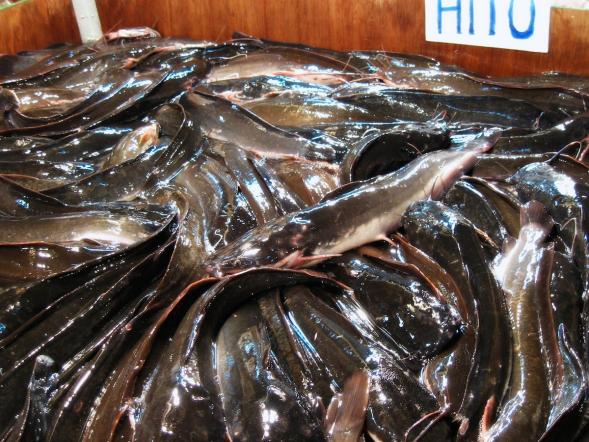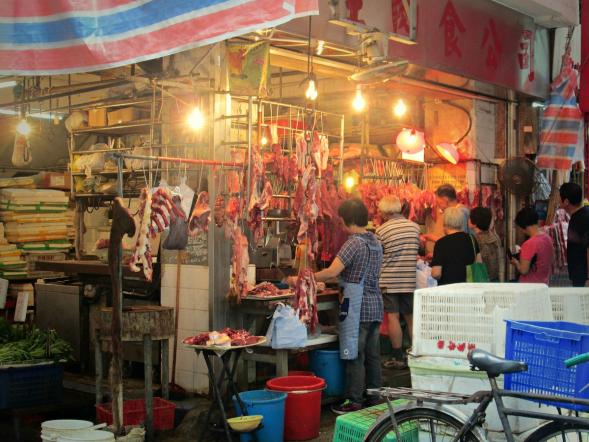Michelin-starred restaurants, street food stalls, and bucolic vineyards have always been top destinations for gastro-tourists, but open air markets and farmers' markets are now making the food tourist’s must-visit list, as well. Full of sights, sounds, and smells missing from sterile tourist centers, these sensory wonderlands offer visitors a way to experience authentic local foodways, especially in foreign countries, where the marketplace can be notably different than the neighborhood farmers market.
But one feature of markets around the world that is rarely showcased in guidebooks or travel blogs is the sale of live animals for food. From Asia to Africa and Latin America to the Middle East, picking up fresh meat often requires picking out a live creature first and then watching as it is butchered (or doing it yourself at home) to ensure proper preparation. Even in North America, where meat production is largely industrialized and out of sight to consumers, urban abattoirs and fresh meat markets are being revived to meet the demands of immigrants who are used to seeing their meal walking or squawking just a few hours before dinner time.
While the purchase of live lobsters, crabs, or fish straight out of the tank may not disturb many U.S. consumers, the sale of live creatures such as turtles and frogs not found in the everyday American diet has set animal rights activists against multicultural sensitivities in communities from California to the Carolinas. But in other countries, selling live animals for food is a longstanding practice that serves both cultural and practical needs.
A recent visit to the Saturday market in Makati City – a municipality southeast of Manila, where I’ve lived for 3 years since moving from the Twin Cities in 2010 – led me to a stall displaying a tidy pile of frogs – headless, footless, skinless, and still moving. A fellow shopper, perhaps seeing my horrified expression, commented reassuringly, “At least you know they're fresh.”
Freshness is perhaps the most important and universal reason for purchasing live animals, especially in communities where refrigerating perishable foods in the marketplace and at home are beyond the means of many. Offering still-viable food is an economic strategy for vendors like the chicken farmer in a rural Philippine palengke, or wet market, who keeps his birds alive until they are sold to minimize costly waste and to ensure he still has fresh stock the next day. In turn, customers can inspect live animals, choose the one they prefer, and be assured that the meat has not being sitting around in the heat and dust for hours.
----
 Hito Catfish at Cubao Farmers' Market in Metro Manila
Hito Catfish at Cubao Farmers' Market in Metro Manila
In my travels around Asia, I have seen a writhing mass of hito (native catfish) glistening underneath a string of mini-light bulbs at the Cubao Farmers' Market in Metro Manila; at the Imbi Market in Kuala Lumpur, I observed chickens placidly awaiting their fate in stacked metal cages. But nothing compares to the sheer variety of specimens that can be found in China's many markets.
If most shoppers desire freshness in food, Chinese consumers absolutely demand it, particularly in the southern coastal province of Guangdong (anglicized as Canton). Surrounded by fertile farmland and ocean waters, the Cantonese have access to abundant fresh meat and produce around which they have developed a cuisine focused on bringing out and enhancing natural flavors.
"They are adamant about live [animals when buying meat]. They like to see the fish swimming when they pick it," explained Janice Leung Hayes, a Hong Kong-based food writer and co-founder of Island East Markets, a Sunday organic food and handicraft market. Fellow Chinese from other parts of the country do not necessarily share her outlook. Janice recalled a neighbor – “From Beijing, I think” – who gave her a gift of whole crabs, excitedly telling her how fresh they were as they had just died. “My cousin and I looked at each other [as if to say] ‘They died?’ That's too late - you have to kill them when you get home,” she explained.
This dedication to preserving the natural taste of food has helped support the continuation of live animal markets to supply fresh ingredients, and it has earned Cantonese cuisine a deserved reputation for sophistication and fine dining. But biological hazards lurking in live animals markets have given an entirely new and frightening meaning to the term ‘food-borne illnesses’.
---
 Fresh meat at the Wan Chai market in Hong Kong
Fresh meat at the Wan Chai market in Hong Kong
At the live animal markets in China, a bewildering array of creatures can be found clustered together, including reptiles, amphibians, and insects, and common animals considered taboo in other food cultures, such as rats, dogs, and cats. The diversity and prolonged proximity of wild and domesticated animals alongside humans have closed the natural gap that typically helps to keep dangerous unknown pathogens in check.
An influenza virus, for instance, infects a host's cells via receptors that are usually specific to the species. But mutations in a virus's genetic code can occur during cellular reproduction, resulting in strains that are slightly different each time - consider seasonal flu and how different flu vaccines must be formulated every year. Sometimes, these mutations result in changes to the receptors, allowing a virus to jump to a new species. In a process known as reassortment, different strains of a virus that have infected the same cell may swap genetic material and create a new pathogenic strain. For example, if an influenza virus from an unknown species manages to infect a bird that already harbors a virus to which humans are susceptible, reassortment may lead to yet another pathogen infectious to humans.
Having so many disparate species, both wild and domesticated, in prolonged close contact with each other and with people, as they are in live animal markets, increases the risk of such an event. In just the past decade, there have been deadly outbreaks of three highly pathogenic viruses that could be traced back to China's live animal markets: severe acute respiratory syndrome (SARS) in 2003, which may have jumped to humans from wild civet cats sold as food; Avian Influenza H5N1 later that same year; and Avian Influenza A (H7N9), which first emerged at the end of March this year, both of which were likely spread from infected poultry.
With H7N9, poultry markets in China were shut down within a week of the first reports. Economic losses were estimated at US $6 billion, but such immediate action helped contain the spread of the contagion. According to one news report, officials in Shanghai, China's most populous city, are now encouraging consumers to buy pre-butchered chickens. Habits may be hard to change however: about 70% of the nearly 180 million chickens consumed by residents annually were bought live, so authorities plan to reopen a reduced number of markets, albeit under stricter regulations. But given live markets’ rather frightening track record as a kind of Ground Zero for virulent diseases, it would seem more prudent to discontinue the practice altogether.
Short of such a drastic measure, Hong Kong, which was hit hard by the '03 outbreak of SARS, has taken action toward protecting its citizens against similar health crises while still trying to preserve some aspects of traditional food customs. When the city reopened poultry markets, they instituted ‘rest days’ – one day each month when the markets are closed for a complete cleaning. Leung Hayes also noted a trend toward moving street markets to indoor venues where more sterile conditions can be maintained.
---
Ultimately, the allure of open-air live-animal markets lies not only in their vivid sights and scents, but also in the opportunity they provide to eliminate the industrialized layers obscuring the natural environment from which we source our food. For me, it has been even more fun to see this relationship through the lens of another culture whose practices may be unfamiliar, and in some cases alarming, but whose goals – to find and provide good, fresh food – are the same as the ones I am used to from the local movement in United States. In this context, live animal markets serve a trusted and integral role; in another light, however, they can also represent the careless mishandling of nature that ultimately comes back to bite us.

Tracey Paska lives, eats and writes in Manila, Philippines, where she revels in the fact that she can wear flip-flops outdoors in January. When she's not exploring Manila's foodscape, she freelances for a national food magazine and writes about the complex and fascinating connections between food, culture, and society on her blog Tangled Noodle. Follow her at @TangledNoodle. Her last article for SGT was Globally Aware: Be My 'Suki': A Market Relationship in the Philippines.

